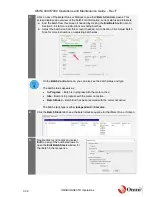
OMNI 4000/7000 Operations and Maintenance Guide
– Rev F
3-51
OMNICONNECT® Operations
The
Error Select
entry is used to determine whether the secondary variable should
be prevented from falling below or rising above its setpoint. The control action
selected for the primary and secondary variables also affects the setting for this
entry (Step 4).
This entry must be set to
High Error Select
in applications using only one control
variable, as the unconfigured control variable always has a zero error.
9.
Repeat Steps 4 and 5 for the secondary
control variable, if using.
The secondary
Gain Factor
is used to trim out response variances between the
primary and secondary variables. For example, movements in the control valve may
produce a larger response in pressure than in flowrate. In this case, the secondary
Gain Factor
is adjusted to a value that is less than one, ensuring a consistent
system gain when control is automatically switching between primary and secondary
variables. An initial value of 1.0 assumes that the primary and secondary variable
have the same response to control valve movement.
10.
Click
Apply
to save your changes.
3.7.3 PID Ramp Control Configuration
To minimize the possibility of equipment damage or spills resulting from rapid startups or
shutdowns, some applications require that the flow be slowly ramped up to the setpoint and then
ramped down. Two PID permissive flags (1722 and 1752) control the startup and shutdown ramp
functions, and these permissives may be manipulated using Boolean statements or remotely
through Modbus writes.
PID Start, Shutdown and Stop command points, which are manually controlled through the front
panel, eliminate the need to manipulate the PID permissives directly. Using these command
points greatly simplifies operation of the PID ramping functions.
In OMNICONNECT, you can configure the startup ramp, shutdown ramp and minimum output
percentages. To access these setup options, follow these instructions:
1.
In the Actions ribbon, click
Configure
.
















































